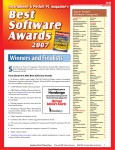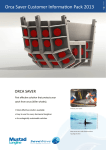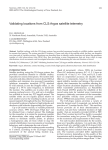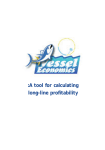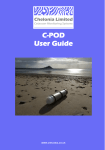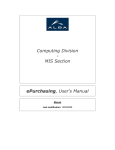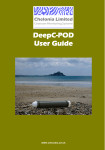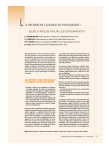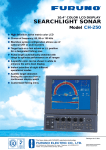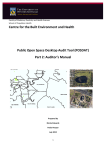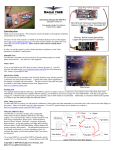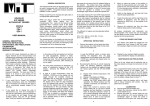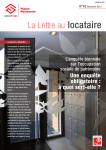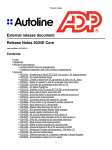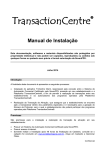Download more information
Transcript
Rotating SeaBird Saver Information Pack 2015 SEABIRD SAVER The first effective laser solution, helping to prevent seabird by-catch and economic losses due to seabird interference on fishing vessels. Proven to be effective Easy to install and use Ecologically sustainable Content A. Introduction ........................................................................................................................................ 3 A 1. Summary ...................................................................................................................................... 3 A 2. Background .................................................................................................................................. 3 A 3. Bird families interacting with most fisheries................................................................................ 4 A 3.1 Albatrosses ............................................................................................................................. 4 A 3.2 Petrels .................................................................................................................................... 4 A 3.3 Shearwaters ........................................................................................................................... 4 A 4. SeaBird Saver................................................................................................................................ 5 A 5. SeaBird Saver laser technology .................................................................................................... 6 A 5.1 The flight response ................................................................................................................. 6 A 6. Performance ................................................................................................................................. 7 A 6.1 Factors of influence Weather ................................................................................................ 7 A 6.2 Testimonials ............................................................................................................................... 8 A 7. General Advantages of the new Rotating SeaBird Saver ........................................................ 8 B. Technical Data ..................................................................................................................................... 9 B 1. SeaBird Saver Laser specifications ............................................................................................... 9 C. User Manual ...................................................................................................................................... 11 C 1. Introduction................................................................................................................................ 11 C 1.2 Control unit features ............................................................................................................ 11 C 2. Standard Operating procedures ................................................................................................. 15 C 2.1 Initial installing procedures SeaBird Saver Laser...................................................................... 15 C 2.2 Standard Operating Procedures. ......................................................................................... 16 C 2.3 Procedures turning of the product ....................................................................................... 17 C3. Usage tips ................................................................................................................................... 18 C4. Disposal ....................................................................................................................................... 18 D. Warnings ........................................................................................................................................... 19 E. Environmental Responsibility ............................................................................................................ 20 E1. Introduction ................................................................................................................................. 20 E2. Extra Information ........................................................................................................................ 20 E3. Environmentally sustainable ....................................................................................................... 20 2 A. Introduction A 1. Summary There are many conflict situations between fisheries and seabirds. SaveWave is offering an innovative solution to these problems. The SeaBird Saver is a vessel based bird deterrent device that emits a visual (laser) beam that helps deter marine birds. The first version of the SeaBird Saver was developed to deter seabirds from longliners. This new rotating version has more applications for additional types of fisheries. The system can be set up to pan in certain desired areas or can be used to cover a line, just like the stationary SeaBird Saver. A 2. Background True seabirds like albatrosses, petrels and shearwaters, spend the majority of their lives out at open sea, only returning to land to breed and lay their eggs. Many seabirds are opportunistic and know how to make the most of their surroundings. This, together with a great sense of smell, causes a lot of seabirds to interact with fisheries. Baited hooks, lost fish and fish discards are eagerly taken by hungry seabirds. All albatross species are affected by fishing practices and most governments protect albatross species. If protected birds are caught or killed during one season, this can even cause a forced shutdown of fisheries for one year. Another negative effect of seabird predation is the economic loss caused by bait being stripped of the hooks, thus reducing catch rates and increasing bait expenses. But seabird problems are not an exclusive problem to the longline industry. Other fisheries are also affected by seabird by-catch and theft. Both fishermen and seabirds will benefit from our SeaBird Saver deterrent system. 3 A 3. Bird families interacting with most fisheries A 3.1 Albatrosses There are 22 species of albatross found throughout the world’s oceans, of which 17 species are globally threatened. Though they vary in size and (beak) colour, all albatross are easily recognizable due to their enormous size and wingspan. Albatrosses have (like many other seabird species) a tube shaped organ on their beak that helps the birds to excrete salt, making them able to survive without fresh water. Though they are unable to dive, they can dip their heads down and are able to grab food over a meter below the surface. figure 1:Wandering albatross A 3.2 Petrels The family of petrels consists several species of medium to small sized seabirds, all member of the tube-nose group, like albatrosses. Most petrels take their food from the sea surface, but one family of petrels can dive down to gather food. Some members of this family of diving petrels can dive down to a depth of more than 30 metres. figure 2: Northern fulmar A 3.3 Shearwaters Another member of the tube-nosed birds, shearwaters are medium sized, long winged seabirds. The family consists of 30 species mostly found in temperate and cold waters. Petrels feed on fish, squid and similar oceanic food. They can take food from the surface, but some species are also able to dive down into the water and “fly” underwater to a depth of 70 metres. figure 3: Great shearwater 4 A 4. SeaBird Saver The SeaBird Saver system is a bird deterrent based on the strength of a visual stimulis to actively deter sea birds from dangerous interaction areas in fisheries. The visual stimulus is generated through a powerfull wide laser beam, specifically designed to be used on fishing vessels. This beam is most effective in cloudy or dark conditions. The system can be operated as a automated sweeping laser or a static laser beam. The SeaBird Saver system consists of a mounted, yet movable laser source and optional sound system. This laser system is protected against extreme cold and frost by an internal heating system and also a cooling system for internal components. This set up minimizes human effort to operate the system, creating a safer workspace. The system is designed to be mounted on a rail or other high vantage point on board and the laser system needs to be aimed at the desired bird-free zone. This zone can be set-up and adjusted using the controls on the device. In longline fisheries, this often is the prop wash at the stern of the vessel where the baited hooks are set. In trawling, this is often the area where the warp cables enter the water. After aiming and setting a baseline, the sytem can be activated as a static or a sweeping system. figure 4: Illustration of the SeaBird Saver system at work. The red line indicates the baseline. In this case set at 0 degrees. The black lines illustrate the maximum panning range. This being 60 degrees maximum from 0 degrees. The green area indicates the desired bird free area 5 A 5. SeaBird Saver laser technology The technology used in the SeaBird Saver laser is innovative and cutting edge. The emitted laser beam is widened and calibrated in the correct wavelength for optimal visibility and effect on water. No other product can match these parameters. The laser beam and the associated “dot” and scattering effect when it hits the waves is a powerful bird deterrent. Especially effective during dawn, dusk, rainy or foggy conditions. The birds experience this as an unnatural and unpredictable threat. Their natural response to this is to avoid contact and move away. A 5.1 The flight response Every animal is “surrounded” by three zones. Each zone that is breached by a threat leads to a higher state of alert of the animal, eventually leading to flight. The size of these zones can vary greatly per species, activity, animal numbers and even time of year. Zone 1: The threat is noticed, but does not affect behavior greatly. Zone 2: Normal behavior is halted. The threat is assessed and evasion planned. Zone 3: The threat is immediate and triggers a flight response. figure 5: Flight zones (rings not to scale) 6 A 6. Performance The SeaBird Saver is the most sophisticated and high-tech product on the market. It has been specially designed to keep sea birds at a distance from fishing activities. It has proven to be both economically attractive for fishermen and a solution that is ecologically safe and without negative impact on the environment. Its biological efficacy is an important point of attention. In biology there are many factors of influence on the final effect of a product. 100% efficacy simply does not exist in any kind of product that aims to solve a biological problem. Take for instance a simple pill of paracetamol that is used against pain. The efficacy of paracetamol varies greatly between individuals. There are many persons that feel little effect of it and then there are many that really need it. Kids may be more sensitive to paracetamol than adults and people with bowel problems may have little benefits. In general though, if paracetamol – or for that matter any kind of medication – reaches an efficacy level of 60 - 70 % then we have a very successful and useful medicine. The efficacy of the SeaBird Saver should be addressed from a similar perspective. Yes, the SeaBird Saver can indeed greatly reduce the bird problem and yes, the product offers great economic benefits. However, that does not mean that the SeaBird Saver can guarantee to solve the problem for 100% for all bird species, everywhere and under all conditions. A 6.1 Factors of influence Weather Weather conditions can either increase or decrease the efficacy of the SeaBird Saver. The laser is highly effective in low light conditions, precipitation or fog. High light conditions reduce the efficacy of the laser. The laser has been designed to be as visible as possible, but cannot match intense sunlight for power. In light conditions the laser will be less visible to bird’s eyes and therefore less effective. Offshore weather conditions are challenging at best of times, therefore the best technologies have been chosen for the SeaBird Saver to maximize the effect in all conditions. You can make conditions work to your advantage by focusing the usage of the laser system during low light conditions and preferably foggy or rainy conditions to increase its efficacy. By spraying water at the stern of the vessel, rainy conditions can be mimicked to increase efficacy. Line setting at low light conditions greatly increases the efficacy of the Sea Bird Saver and minimizes bird predation. 7 A 6.2 Testimonials “The SBS is working fine and it is 100% effective, no birds on the line since we use it” - Captain of Chilean longliner - 2015 “When I saw the video of the seabird saver, I did not believe what I saw! Now I am using it and I am convinced. The laser is perfect, it keeps the birds far away from the boat! We catch significant more fish on the hooks said while using the SeaBird Saver“ – Captain of Norwegian longliner - 2014 “The laser was striking over the gear being deployed from 50 feet to half a mile behind the boat. Within 10 minutes there were zero birds within the bait strike zone or within a distance that we could see behind the boat in the dark.” - Captain of an USA Longliner - 2014 “It’s not often a new product comes along that is such a good thing. This could be our silver bullet.” - Captain of a Tasmanian Longliner - 2014 A 7. General Advantages of the new Rotating SeaBird Saver In longlining, heavy tides and side winds can change the path of the longline behind the vessel. By adjusting the panning range for these situations, the right area can be covered with the moving laser beam. The laser allows for fast turns of the vessel and even backing up when desired. The movement from the rotating product creates extra unpredictability and can therefore increase efficacy in difficult circumstances. By using the right settings (see manual) the product is suitable for all types of fisheries, for instance trawling and purse seining. The Horizon Safety System shuts down the laser emission if the beam moves above the horizon, preventing unwanted situations. 8 B. Technical Data B 1. SeaBird Saver Laser specifications Optical Laser Class Color laser beam Wavelength Approximate service life laser source 3B Green 532 nm 10000 hrs (during normal operating conditions) Electrical Power Cable length power supply - laser 100 V – 230 V 1.5 m Environmental Optimal operating temperature Relative humidity Storage temperature -20 °C to +25 °C 0 % - 95 % - 30 °C to + 45 °C Laser source and movement system Weight Length Width Height Approx 10 kg 450 mm 300 mm 200 mm Mechanical power supply box Weight Length Width Height Approx 20 kg 500 mm 400 mm 250 mm Safety Interlock system LED output emission indicator Safety key control Beam shutter On/Off switch Horizon safety system Emergency stop button Yes Yes Yes Yes Yes Yes Yes 9 10 C. User Manual C 1. Introduction Operating the SeaBird Saver must become a routine procedure onboard when fishing. It is therefore very important to read the following instructions and to work accordingly. The SeaBird Saver system is designed to be mounted on a rail or other high vantage point on board. From here the laser source has to be aimed at the desired bird-free zone. In longline fisheries, this would be the prop wash at the stern of the vessel where the baited hooks are set. In trawling, this is generally where the warp cables cut into the water. The control box can me mounted on a vertical flat surface, with the laser source being mounted close to it on a solid flat surface Before operations, the fishing master or commanding officer must make sure the system is used safely. The person on board handling the laser system must wear the eye protection provided. Make sure the laser beam does not point above the horizon, at other ships, at land or at reflective surfaces. Adjust the horizon safety feature, and vertical pitch to accomplish this. When the person in charge of operations gives the all clear, turn the laser on by pressing the laser on/off button in the control unit (see operations) At the end of operations the system can be switched off at will. If the system has been exposed to salt spray, clean the system with a moist cloth. The SeaBird Saver is designed to cope with salty environment, but minimizing exposure time to salty conditions and good cleaning will improve lifespan of the product. C 1.2 Control unit features In this new version of the SeaBird Saver there are a lot of features that can be adjusted inside the control unit. On the control panel inside the control box , different turn screws are placed to create the optimal movement pattern of the laser system for the vessel in specific circumstances. It can be adjusted at any time. Horizon safety system This innovative system (fig. 6) automatically shuts down the laser emission when the laser is aiming above the adjustable angle of the laser beam. It will also immediately start emitting again once below the chosen angle. The Horizon Safety System makes the product much safer in operation for nearby human activity and does not target birds just flying above the vessel. 11 Figure 6: The Horizon safety system is set at -10 degrees. The laser will not be able to shine above the angle of -10 degrees from the horizon. Power ON/OFF This is a key switch enabling the system to operate. Only with the key inserted and turned clockwise the system can be operated. There must always be ONE responsible person onboard the vessel in charge of this key and thus be responsible for operation. Logically, when the button is set to ON, the product can be operated. Furthermore, when it is set to OFF, the laser stops emitting but laser cooling components will remain active for about ten minutes. Always use this button to stop the use of the product and not the emergency button, because then there is no extra cooling. Tilt angle With this knob, the vertical angle of the laser from the installing point can be set. (Fig. 8) The vertical figure 7: SeaBird Saver display panel. With movement of the laser beam results from the vessels the Horizon Safety system, Tilt angle, Pan angle, Pan range, movement Speed, laser movement on the sea waves and is sufficient as our on/off and scanning on/off dials and buttons trials and feed-back from users have concluded. For trawlers for instance, the vertical angle will be set in such a way that the laser point just in front of the trawling lines. In longlining the laser must point just above the point where the longline enters the water and for purse seining this can vary. 12 Figure 8: Tilt angle can be adjusted from +10 to -30 degrees from the horizon. Please note that the tilt angle is not set equal to or higher than the horizon safety, or the laser will not be activated. Pan angle With this knob, the horizontal baseline of the laser is set, from which all controlled movements take place. When there is no movement of the laser selected, this is where the laser is aimed at. (Fig. 9) For instance, in normal conditions while longlining the laser would be lined up with the main line. In heavy side winds or current, the baseline can be adjusted to keep in line with the main line. This option is also useful when the product can’t be mounted in the center of the vessel. figure 9: the pan angle can be adjusted between -60 and +60 degrees on a horizontal axis. This number is the baseline for SeaBird Saver operations, whether stationary or panning. Pan range The product is equipped with a maximum horizontal movement range of 120 degrees: 60 degrees left and 60 degrees right. The movement (left and right) from base line can be selected between 0 en 60 degrees with this turn screw. Example1: If the Pan angle is for instance set at +10 degrees and Pan range at 30, the laser will pan from -20 degrees of the 13 products center installation point to +40 degrees on the right, making a panning range of 60 degrees in total. (Fig. 10) figure 10: Pan range as explained in example 1. Pan angle (baseline) is set at -10, with a pan range of 30 (30 degrees to either side of the baseline). This makes the product pan in a 60 degree area from -20 to +40 degrees. Example 2: If the Pan angle is set at 50 degrees to the left and Pan range is set at 30, the laser will only cover the 10 remaining degrees to the left from the baseline (because of the 60 degree maximum) and 30 to the right. Seen from the center of installation, it will thus cover the area from 60 degrees to 20 degrees on the left side. (Fig. 11) Figure 11: Pan range as explained in example 2. Pan angle (baseline) is set at -50, with a pan range of 30 (30 degrees to either side of the baseline). Due to the pan limit of -60, the SeaBird Saver will not pan any further, resulting in a pan of a 40 degree area from -20 to -60 degrees. 14 Speed With this knob the speed of which the laser moves from side to side can be adjusted. This could be factor of influence for the efficacy of the product. For wider ranges, the speed might be set higher to give the birds no chance to take fish while the laser is on the other side. The speed might be a key indicator of efficacy. Laser On/Off The button that actually turns the laser beam on. This will only work when the system is also turned on with the key. Please note that the Pan angle must be below the horizon safety system value to be emitting. Scanning On/Off Only when this button is pushed, the laser will start its selected movement pattern. By not using the scanning option, the laser becomes a stationary laser like our previous product and a comparison of efficacy can be made if desired for testing purposes. C 2. Standard Operating procedures Make sure that all responsible persons in the crew know exactly how to handle the product. C 2.1 Initial installing procedures SeaBird Saver Laser Chief Mechanic (CM), together with Fishing Master(F) is in charge of installing the SeaBird Saver laser safely. 1 2 3 15 1) Mount the control unit (1) on a (vertical) flat surface close to where the laser source needs to be installed. Preferably not more than one meter away. 2) Mount the laser source (2) on a horizontal flat surface with the laser pointing to the bird free area. Make sure the metal bottom plate is mounted lengthwise, since the 0 degree baseline is perpendicular to this direction. So mount it the way you see it in the picture above, with the laser aiming towards the sea. 3) Mount the emergency button close to the device (3) 4) Connect the four cables connectors of the laser source to the control unit receptors. 5) Plug the power cable into a socket, preferably one that is indoors. The system is now ready to be used C 2.2 Standard Operating Procedures turning on the SeaBird Saver laser for use We have supplied a short video of how to operate the Rotating SeaBird Saver. Make sure that you watch this video, besides reading this manual carefully. Captain (C) is in charge and appointed as “laser safety officer”. Fishing (F) master is executing laser officer. 1. (C): Decide on the start of using the SeaBird Saver. 2. (C): Communicate with the Fishing Master that the standard operation procedures are now being followed and the product is going to be used. 3. (C): Provide the control unit key to the Fishing Master. 4. (C): Provide the master key for the control unit to the Fishing Master. By handing over the keys, the Fishing Master (F) is now in charge of operations. 5. 6. 7. 8. Put on the protective eyewear when starting these standard operating procedures for extra safety. Check if the SeaBird Saver laser is positioned well and aimed at the desired direction. Check if the protective lens cover is covering the lens. Only if indeed product checks 5-6 are done and indeed positioning and aiming plus lens cover are in order, carry on with the procedures hereunder from point 9 on. If not, make sure that by following the initial installing procedures with the Chief Mechanic, these points are met! 16 9. Check and make sure there is no human activity in the direct laser-line or area for at least 1000 metres. If there is, please evaluate safety. 10. Open the control unit with the provided casing key. Insert the master key in the power supply and turn it clockwise to ON position. 11. Set Horizon Safety System angle. The system switches off automatically after passing the set safety angle. 12 . Set Tilt angle to place the product in the right vertical position (please note that the tilt angle must not exceed the horizon safety angle for the laser to emit) 13. Set Pan angle. The pan angle is the baseline which is used during the panning motion. 14. Set pan range. The pan range is the amount of movement deviation from the baseline on each side of the baseline. 15. Select movement speed. 15. Activate laser by pressing laser on/off button. 16. Activate panning motion by pressing scanning on/off button. 17. Close control unit. The SeaBird Saver is now fully active 5 C 2.3 Procedures turning of the product 18. Open control unit. 19. Deactivate system by pressing both scanning and laser on/off buttons and turning and remove the master key. Note that the internal cooling system will stay activated for some time after switching off and removing key. 20. Close control unit. 21. Put back the laser protective cap. 22. Return master key an control unit key to captain for safe storage. 17 Extra: Only in emergencies, the system can be shut down by pressing the Emergency button. Note that the cooling does not remain active, so do not use this button as the normal on/off button! Reactivation by rotating the emergency button. C3. Usage tips The bird must be able to see the green laser dot or beam to achieve scaring effect. Be aware of weather situations and surface orientation to optimize efficacy. Dark, rainy or foggy conditions are optimal conditions to have maximum efficacy of the laser. Try to create panic in a group: panic reactions in a group improves deterring. Improve visibility and deterring power in bright daylight conditions of the laser system by spraying water through the laser beam. C4. Disposal Dispose the product, after its life span has run out, according to your local legislation. In many counties, the SeaBird Saver must be disposed of as “electronic waste”. 18 D. Warnings Keep these very important things in mind when using the SeaBird Saver: SaveWave and Mustad Autoline are not responsible for any misuse of the SeaBird Saver. The SeaBird Saver can and must only be used according to local government laws and for the purpose it has been designed for: keeping seabirds at a safe distance from fishing activities. Always follow the manual and standard operating procedures. If there are any doubts, questions or problems: Stop using the SeaBird Saver and contact Mustad Autoline immediately!! 19 E. Environmental Responsibility E1. Introduction SaveWave is a small and dynamic Dutch company, specialized in the development of ecologically sustainable solutions to help fishermen and sea animals interact in the world's oceans. Every year dolphins, porpoises, tortoises and seabirds are hurt or die due to interactions with fishing gear. Due to this negative interaction, some animal species are threatened. Our mission is to save these animals with solutions that are attractive for fishermen worldwide. We reach this objective through products that are acceptable from a biological sustainable point of view and at the same time being economically attractive for people and companies whose livelihoods depend on the seas. E2. Extra Information Longline fishing is one of the most sustainable methods in commercial fishing. This is caused by a reasonable selective fishing method & limited bycatch compared to other fisheries. Still, unwanted bycatch does occur, especially in the form of unwanted bird catches. This bird problem causes a lot of financial setbacks to the fisheries, caused by bait predation and a smaller catch as a result. Furthermore, bycaught protected species like albatrosses can cause a (temporary) shutdown of the fisheries in a certain areas by supervising organizations. Though the complete exclusion of bird species in fisheries is impossible, an effort must be made to keep birds away from the immediate danger zone. E3. Environmentally sustainable Since SaveWave is a green company, we will never develop products that are harmful to the environment. One of our products, Vibe-Lite, is even developed to stop the enormous environmental impact of light sticks used in longlining. The Orca Saver is our answer to the orca line predation problem in longline fisheries. Partnerships with WWF and Dolphin Fund are good examples of our philosophy. Therefore we cannot (and by our philosophy will not!) develop products causing harm to animals. In 2010, SaveWave was selected from over 100 companies by the Dutch government to receive funding for this project. This once more shows that SaveWave is a company with a mission to save sea life, in which environmental organizations, our government and fishermen truly believe. Winning the 2014 WWF SmartGear award for Tuna Bycatch Reduction Prize (issued by John West) is the best example of our philosophy. 20




















